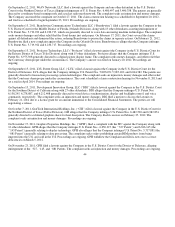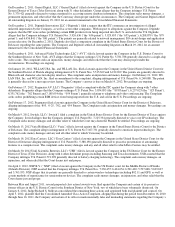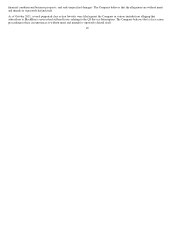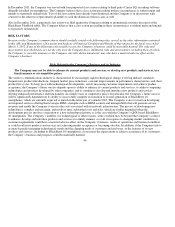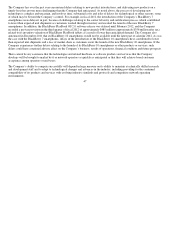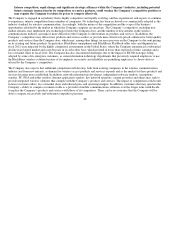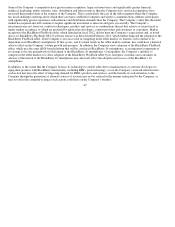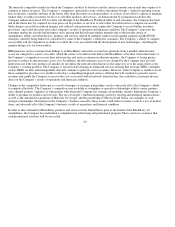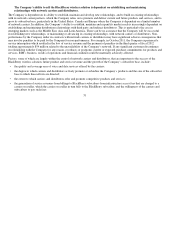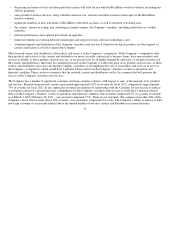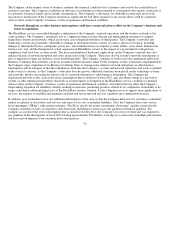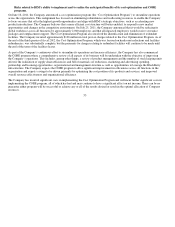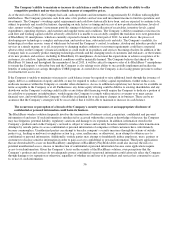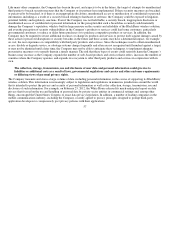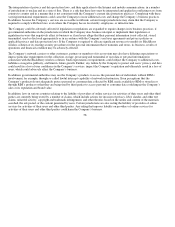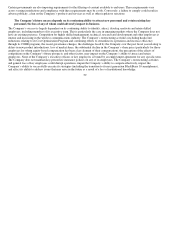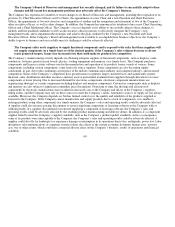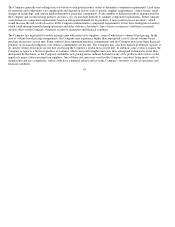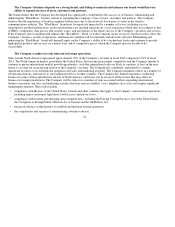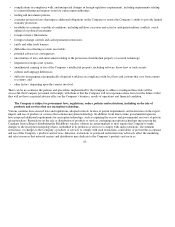Blackberry 2012 Annual Report Download - page 61
Download and view the complete annual report
Please find page 61 of the 2012 Blackberry annual report below. You can navigate through the pages in the report by either clicking on the pages listed below, or by using the keyword search tool below to find specific information within the annual report.
The Company, in the normal course of business, monitors the financial condition of its customers and reviews the credit history of
each new customer. The Company establishes an allowance for doubtful accounts intended to correspond to the specific credit risk of
its customers, historical trends, and economic circumstances. The Company’s allowances for doubtful accounts may prove to be
inaccurate or insufficient. If the Company experiences significant net bad debts expense for any reason, there could be a material
adverse effect on the Company’s business, results of operations and financial condition.
Network disruptions or other business interruptions could have a material adverse effect on the Company’s business and
harm its reputation.
The BlackBerry service is provided through a combination of the Company’s network operations and the wireless networks of its
carrier partners. The Company’s operations rely to a significant degree on the efficient and uninterrupted operation of complex
technology systems and networks, which are in some cases integrated with those of third parties. The Company’s networks and
technology systems are potentially vulnerable to damage or interruption from a variety of sources, physical or logical, including
damage or interruption by fire, earthquake, power loss, telecommunications or computer systems failure, cyber attack, human error,
terrorist acts, war, and the threatened or actual suspension of BlackBerry service at the request of a government for alleged non-
compliance with local laws or other events. The increased number of third party applications on the Company’s network may also
enhance the risk of network disruption and cyber attack risk for the Company. There may also be system or network interruptions if
new or upgraded systems are defective or not installed properly. The Company continues to work to develop, implement and test its
Business Continuity Plan and there can be no assurance that the measures taken by the Company to date, or measures implemented by
the Company upon completion of its Business Continuity Plan, to manage risks related to network disruptions or other business
interruptions will be adequate or that the redundancies built into the Company’s systems and network operations will work as planned
in the event of a disaster. As the Company’s subscriber base has grown, additional strain has been placed on the technology systems
and networks, thereby increasing the relative risk of a network disruption or other business interruption. The Company has
experienced network events, such as the service interruption that occurred in October 2011, and, any future outage in a network or
system, or other unanticipated problem, that leads to an interruption or disruption of the BlackBerry service, could have a material
adverse effect on the Company’s business, results of operations and financial condition, and could adversely affect the Company’s
longstanding reputation for reliability, thereby resulting in end users purchasing products offered by its competitors if reliability is no
longer considered a differentiating factor of the BlackBerry wireless solution. As the Company moves to support more applications or
services, the expense to establish and maintain a resilient and secure network services capability may significantly increase.
In addition, poor performance in or any additional interruptions of the services that the Company delivers to its customers could delay
market acceptance of its products and services and expose it to costs or potential liabilities. Also, the Company enters into service
level agreements (“SLAs”) with certain customers. The SLAs specify the events constituting “down time” and the actions that the
Company will take to rectify or respond to such down time, including in certain cases, the payment of financial penalties. For
example, as a result of the service interruption that occurred in October 2011, the Company lost service revenue and was required to
pay penalties in the third quarter of fiscal 2012 totaling approximately $54 million, is facing class action suits in multiple jurisdictions
and has received inquiries from consumer protection agencies.
53


